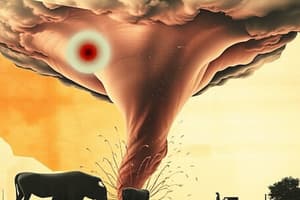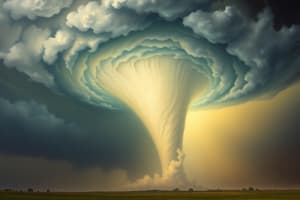Podcast
Questions and Answers
What is a tornado?
What is a tornado?
- A large thunderstorm with winds already in rotation
- A type of tropical storm with wind speeds of up to 250 miles per hour
- A column of violently rotating air formed during thunderstorms (correct)
- A type of cyclone that occurs in Tornado Alley
Where are tornadoes most likely to occur?
Where are tornadoes most likely to occur?
- Southern Canada and Tornado Alley (correct)
- Southern Canada and Florida
- Northern Texas and eastern Colorado
- South Dakota and Nebraska
What is a supercell?
What is a supercell?
- A thunderstorm with a single updraft of hot air
- A type of cyclone that forms during late spring and summer
- A large thunderstorm in which winds are already in rotation (correct)
- A tropical storm with wind speeds of up to 250 miles per hour
What does the term 'tornado' mean in Spanish?
What does the term 'tornado' mean in Spanish?
How many instances of tornadoes does the United States experience each year?
How many instances of tornadoes does the United States experience each year?
When are the majority of tornadoes likely to form?
When are the majority of tornadoes likely to form?
What is the statistical likelihood of a supercell producing a tornado?
What is the statistical likelihood of a supercell producing a tornado?
What is the primary factor that leads to the formation of a tornado?
What is the primary factor that leads to the formation of a tornado?
What is the role of an updraft in the formation of a tornado?
What is the role of an updraft in the formation of a tornado?
What technology do meteorologists use to look for hook echoes indicative of a supercell, providing warnings of an approaching tornado?
What technology do meteorologists use to look for hook echoes indicative of a supercell, providing warnings of an approaching tornado?
How are tornadoes categorized by meteorologists?
How are tornadoes categorized by meteorologists?
What is the primary purpose of stormchasers in relation to tornadoes?
What is the primary purpose of stormchasers in relation to tornadoes?
What is the primary difference between the Fujita-Pearson (FPP) scale and the Enhanced Fujita (EF) Scale?
What is the primary difference between the Fujita-Pearson (FPP) scale and the Enhanced Fujita (EF) Scale?
What is the role of the National Weather Service in evaluating tornado damage?
What is the role of the National Weather Service in evaluating tornado damage?
What is the primary impact of a tornado's path length on its level of destruction?
What is the primary impact of a tornado's path length on its level of destruction?
Flashcards are hidden until you start studying
Study Notes
Tornado Basics
- A tornado is a rotating column of air that descends from a thunderstorm to the ground, causing damage.
- Tornadoes are most likely to occur in areas known as "Tornado Alley" in the central United States.
Supercells
- A supercell is a type of thunderstorm that is characterized by a rotating, towering column of air known as a mesocyclone.
- The term "tornado" translates to "tornillo" in Spanish.
Tornado Frequency and Timing
- The United States experiences an average of 1,200 instances of tornadoes each year.
- The majority of tornadoes are likely to form during the spring and summer months.
Tornado Formation and Detection
- The primary factor that leads to the formation of a tornado is the presence of warm, moist air near the surface and cooler air above.
- An updraft plays a crucial role in the formation of a tornado, as it allows warm air to rise and cool air to sink, creating rotation.
- Meteorologists use Doppler radar technology to look for hook echoes indicative of a supercell, providing warnings of an approaching tornado.
Tornado Classification and Stormchasers
- Tornadoes are categorized by meteorologists based on their wind speed, ranging from EF0 (light damage) to EF5 (incredible damage).
- The primary purpose of stormchasers is to gather data and footage of tornadoes, which helps improve tornado forecasting and warning systems.
Tornado Scales and Damage Evaluation
- The primary difference between the Fujita-Pearson (FPP) scale and the Enhanced Fujita (EF) Scale is that the EF scale takes into account more variables, such as wind speed and area affected.
- The National Weather Service is responsible for evaluating tornado damage and assigning a rating based on the EF scale.
- A tornado's path length has a significant impact on its level of destruction, as longer paths tend to cause more widespread damage.
Studying That Suits You
Use AI to generate personalized quizzes and flashcards to suit your learning preferences.





